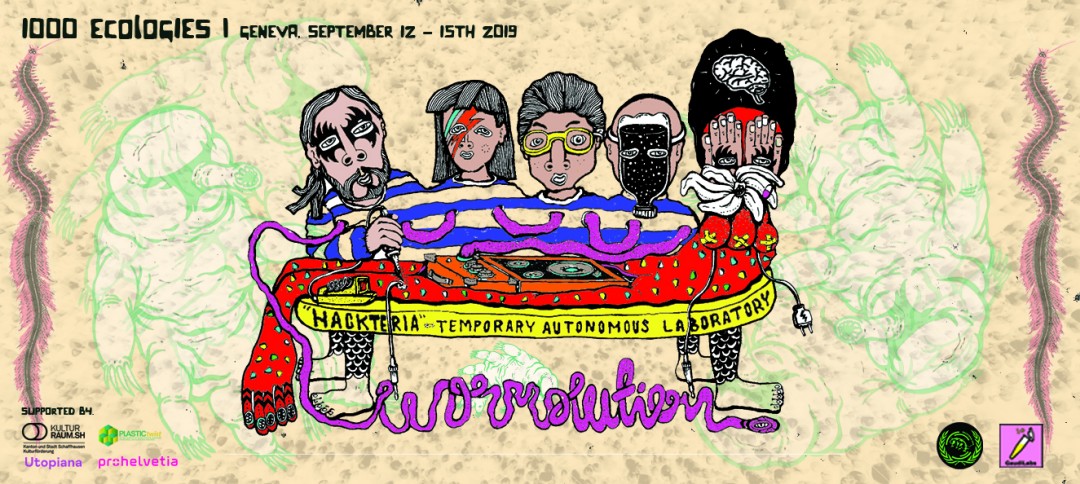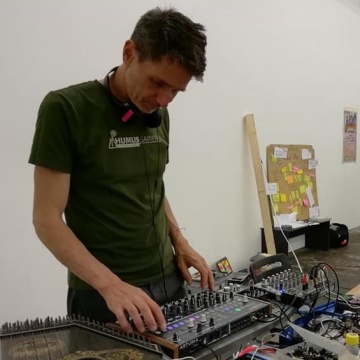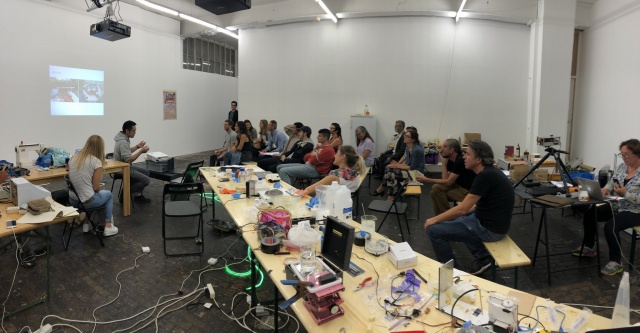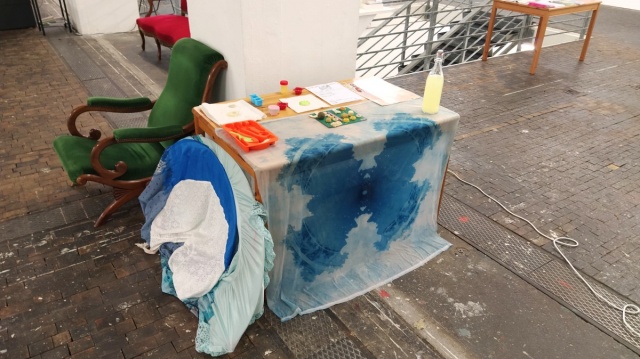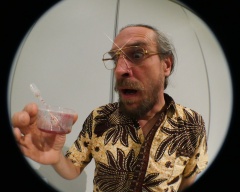Wormolution - Hackteria Temporary Autonomous Laboratory at 1000 Ecologies, Geneva
Keywords: Worms, Soil, Circular Economies, Plastics, Textiles, Metabolism, HLabX, Environment-culture, Lasers, Ecology and Life Sciences, Relational Biosphere
Overview
Hackteria coordinates a Temporary Autonomous Laboratory during the early phase of “1000 Ecologies” inviting international researchers, artists and entrepreneurs as participants. The lab as a temporary construction should allow researchers from the fields of biology and engineering to collaborate with artists and so create links between the "two cultures", the human sciences and the arts. On the topic of “Wormolution” participants will explore the territory between plastic as the abundant material of our society and the natural metabolisms and processes in nature. By combining their expertise, share simple instructions and engaging in critical and theoretical reflections artists and scientists will create new ways to combine multiple ecologies, maybe in a circular, maybe in a whole new way of freedom and awareness.
Schedule
12. - 15. September, Le Commun, Geneva, Switzerland
General Opening Hours: 11 am - late
Opening Night
Thursday 12. September
- 20:00 Opening Night / public talks
Workshops
Saturday 14. September
- 14:00 - 18:00 Workshop by international participants
During these parallel workshops we will lead you through our core topics of the TAL and give you hands-on experiences of working together with our participants. Please come on time, first-come-first serve, to reserve your participation.
Plastikologi | Let's Make Plastic Together - From Molecules and Proteins to Polymers
Everybody talks about plastic these days. But what are those "evil" materials? While some plastics are made synthetically from resources such as crude oil and are said to last for hundreds of years, if dumped into the environment, other plastics are renewable, compostable or even edible. Let's make our own plastics together!
Wormolution | Create a plastic-worm-device for a daily application - A Speculative Design Adventure
During this speculative and collaborative prototyping session we will explore the domestic use of futuristic biotechnologies to help our daily lives through re-cycling, up-cycling, bio-synthesis, cyber-composting using our cute little helpers THE WORMS!
Finissage
Sunday 15. September
- 11:00 TAL Discussion with Brunch
- 19:00 TAL Finissage / public with foods, experiments and drinks
TAL Work-Schedule
Pre-Program: Wednesday 11. September
- 10:00 Go to the flea-market!!!
- arrival of first participants
- 21:00 Cave12 Concert
Thursday 12. September
- 11:00 Collaborative process of setting up the lab
- arrival of more participants
Friday 13. September
- 10:00 Collaborative experimentation
Saturday 14. September
- 10:00 Collaborative experimentation
Sunday 15. September
- 10:00 Summarizing our explorations and documentation
Ideas and Projects to work on
For now we mostly discuss our project ideas on the forum. We will then document them here in more detail.
Cheesy Plastics Explorations
Since 1900 people have made "plastics" from milk, aka the protein in milk called Casein. It was called Galalith, and widely used for fashion, buttons and handles for knifes. It is still in use for special knitting needles or plektrums for guitarist. And as usual in the 21st century we see a lot of fuzz about the "first" bioplastics from milk in various media and design shows. Wheypack.eu seems to use genetecilly modified e.Coli to produce a plastic from whey in a fermentation process of lactic acid. While others are more open to tell the story of a lost and forgotten material from 100 years ago, such as this instructable.
Most instructions just curdle milk with vinegar and dry it, to create some kinda of a block of super hard "paneer". See this youtube instructions, allthough the original synthesis is chemically crosslinking the casein molecules with formaldehyde, which should make the material much stronger and less brittle.
Speculative Design Sprint
Short Design Workshop to explore concepts and ideas, with the goal of creating a futuristic plastic-worm-device for a daily application! In Industrial Design, it's all about generating applications for the newest technology and research. In a 1 hour sprint, we will come up with ideas, select them and evolve them in groups. The groups will use sketching, writing and paper-prototyping to portray their device and present it to the others in a short pitch.
Location
Exhibition spaces "Le Commun", Building of Contemporary Art (BAC), Geneva
For projects in the fields of contemporary art, multidisciplinary, performative and digital arts. The Common is an area of freedom, without artistic direction. On a ground floor and first floor there are 730m2 of open space.


28 rue des Bains,
https://goo.gl/maps/b3HSFWJE8LshJXY78
Participants
Kat Austen (UK/DE)
Kat Austen is a person. In her artistic practice, she focusses on environmental issues. She creates sculptural and new media installations, music, performances and participatory work. Austen’s practice is underpinned by extensive research and theory, and driven by a motivation to explore how to move towards a more socially and environmentally just future.
Working from her studio in Berlin, Austen is Artist in Residence at the Faculty of Maths and Physical Sciences, University College London and Teaching Fellow at UCL Arts and Sciences. She was an inaugural member of the London Creative Network and is co-founder of the DIY Hack the Panke collective in Berlin. She holds a Ph.D. in Chemistry. In workshops she explores micro plastics, food, DIY chemistry, DIY spectroscopy, sounds and embodied ways to engage with aquatic environments.
Shih Wei Chieh (TW)
Shih Wei Chieh is a media artist based in Taipei. His wearable art, laser performance have been presented by many global events such as CTM Berlin, SXSW, YouFab, Modern Body Festival, University Technology Sydney etc. His work “Laser Dye” project in 2015 combines laser projection and cyanotype photography innovate the digital printing technology for 3D garments, shoes-wear. He’s also the founder of “Tribe Against Machine”, a social engaged project that invites media artist, e-textile artist to work with Taiwan Atayal tribe community, explore the new role of artist in remote society, how technology should evolve by reflecting to the crisis of the world after capital.
Marc Dusseiller (CH)
Marc Dusseiller aka dusjagr is a nomadic researcher and workshopologist. He is part of the Center for Alternative Coconut Research and co-founder of SGMK and the Global Hackteria Network, Co-organiser of GOSH, Gathering for Open Science Hardware. He loves making DIWO laboratories for creative biological experimentation and works in an integral way, combining science, art and education. He has worked as guest faculty and mentor at various schools, Srishti, Bangalore (IN), UCSB (USA) and in Switzerland, FHNW, HEAD, HSLU, ETHZ. He lives and works in Zürich, Yogyakarta and Taipei. He also loves synthesizers and coconuts.
Eleonore Eisath (IT)
Eleonore Eisath grew up close to nature on a small farm in a mountain village in South Tyrol. She has always been passionate about animals, plants and the processes of nature. After graduation from a business school in Bolzano she wanted to studied chemistry and later discovered industrial design and completed here bachelor studies at the IUAV in Venice in 2014. Eleonore then worked as a designer in a studio in Bolzano, before she went to Oceania for a year and then traveled through New Zealand, Australia, Malaysia and Thailand and got to know all sorts of interesting people there. After here return to Munich in 2016 she applied for a master's degree at the TU Munich. In the first semester already, she came across a paper that dealt with the biotic decomposition of plastic, and since then she can not let go of the idea. She's currently working on a PE-recycling system using waxworms.
Cradle to cradle model, Enzymatic reaction, Bioneering the future
Urs Gaudenz (CH)
Urs Gaudenz is an engineer and interdisciplinary scholar working in Lucerne, Switzerland. He was born 1971 in Seattle USA. He got his master in science of Microtechnologoy from the Swiss Federal Institute of Technology, Lausanne. Subsequent to that he attended Post-Graduate programs in international business and innovation-management. In 2016 completed the course of study in the Principles and Applications of Synthetic Biology as directed by Georg Curch, Professor of Genetics at Harward Medical School. He is founder of GaudiLabs, a third space for third culture. He is a founding member and member of the board of Hackteria International Society. He is currently on the faculty of the Lucerne School for Applied Science and Arts. In his professional practice, Urs Gaudenz makes use of various forms of work and expression such as prototype development, open scientific research and collaborative workshops. He is combining his different backgrounds to explore new technological and cultural fields and his works often emerges out of the void in this intersection. Remarkable in his work is the wide span from speculative and futuristic to very functional and applied. He worked with and was inspired by Dr. Marc Dusseiller - dusjagr labs, the Swiss Mechatronic Art Society, the GynePunk, BioDesign for the Real World, Sci | Art NanoLab Summer Institute at UCLA, LifePatch. He was invited to give workshops or exhibit projects at renown institutions and festivals such as Ars Electronica - Projekt Genesis, ISEA - International Symposium on Electronic Art, DOCK18, space for media cultures of the world, Kapelica Gallery / BioTehna, Schloss Werdenberg, N/O/D/E festival, Medialab-Prado Madrid, CYNETART-Festival - Trans-Media-Akademie.
http://www.gaudi.ch/GaudiLabs/
Corinna Mattner (CH)
Corinna Mattner is founder of the label Romy Hood within she unites her passion for vintage materials, creative transformation and fighting for a better future. With her background as scenographer and organizer of exhibitions she is one of the main brains behind Fashion Revolution Switzerland an helped the movement become big in Zürich, spreading it over Switzerland. For her collections of unique fashion pieces she uses high quality vintage material and outcasted clothes which she turns around, drapes, cuts apart and reconstructs. Since 2017 she is following a series of hybrid escapes for which she is teaming up with biohackers and performance artist, experimenting with eco and bacteria print and performs musical sewing on stage.
Paula Pin (ES)
Paula Pin (Lugo/Spain, 1982), is a researcher and artist activist which has a strong inclination towards research and experimentation processes with collective and free technologies.
She has undertaken residencies at institutions such as CERN, Université Pierre et Marie Curie, Art school KASK in Gent, Prototyp_ome at Hangar Barcelona, Gaité Lyrique in París, Querly Ecologies at Click Festival and GOSH - Gathering for Open Science Hardware in Shenzhen, China. Although her work emerges from within a scientific tradition of research and experimentation, running throughout drawing to abstract video, circuit bending and lab experiments but always located in the intersection where biology, science and queer art collide. Her active participation at Pechblenda Lab and Transnoise laboratories besides her social ideals and the work as a noise performer, has taken her to many spaces and contexts, specially to the point of starting to collaborate in Hackteria, a global biohacking network. Pin had opportunities to give workshops as a facilitator all around the world, always putting the focus on spreading knowledge and sharing experiences on transfeminist horizontal perspectives.
Masato Takemura aka Take (JP)
Masato Takemura. Managing FabLab in Hamamatsu-city, Japan since 2014. Has collaboration workshop with local government and school. Teaching soldering, programming, 3D-printing, 3D-modeling.Also helping for setting up a new FabLab in Hamamatsu science museum and Rwanda. He is trying to add a bio experimental facilities in the labs for education.
Developed some agricultural tools because his FabLab is located in agricultural area and have relationship with farmer. Field monitoring system by drone, Auto steering system for tractor, Sampling machine of bacteria on the crops, Weeding robot in the rice field. Together with dusjagr and friends, Take has initiated a series of fab-and-food related experiments under the name HTEAA "How To Eat (Almost) Anything", which has been performed in Seoul, Tokyo, Taipei, Boston, Santiago de Chile, Shenzhen and other parts of the world. As a next project, Now trying to grow mushroom for 2 years but never succeeded….
... and friends
You want to join as a full participant or part-time collaborator? Just get into contact on the forum with us and we will be happy to host you and introduce you into our research processes!
Logistic Info for Participants
Merchandise
We printed some stikkers, posters and spanduk!
Download A3 poster File:draftPoster_wormolution_newBack.pdf
Related Projects on this Wiki and the WWW
Hackteria Forum:
https://forum.hackteria.org/t/lets-start-discussing-hackterias-tal-wormolution-12-15-sep-2019-geneva/598/7
Silk:
https://www.hackteria.org/wiki/Back_to_Bombyx
http://www.gaudi.ch/HTGAA/#Class10
http://2014.igem.org/wiki/images/4/4e/Silk_Materials_Protocol_Paper.pdf
Microplastics:
https://www.mdpi.com/1660-4601/15/2/280
https://www.hackteria.org/wiki/HUMUS.Sapiens_on_TOUR
PlasticTwist:
https://ptwist.eu/
Support
Hackteria TAL "Wormolution" has been invited by Utopiana supported through funding from Pro Helvetia, Lotterie Romandie and the City of Geneva. Travel support for international particiapants is co-funded through the "Förderbeitrag" of KulturRaum Schaffhausen with the HLab X Fellows Programme.
Additionally the project is supported by the European Union’s Horizon 2020 Research and Innovation Project PlasticTwist. The aim of the PlasticTwist project is to revalue recycled plastic by supporting multiple actors, citizens, communities, inventors, innovators, entrepreneurs, public institutions, in co-creating and sustaining new forms of plastic-as-an-asset practices, strengthening both societal and circular economy actions in-line with digital social innovation principles.
Credits
Hilarius!!!
- Artworks by Efnu Nirvana
Notes from the facebook wormolution group
Le Commune
Side programm
noise concert: 3 DEEPLY IMMERSIVE & DENSE SOLO PROJECTS https://www.cave12.org/mai-mai-mai-torba-simon-de-wildrfid-passage-de-disques/
Flea market
Let's go find lab equipement and plastics on the flea market.
Some specifics we can look for you?
What about sewing machine
Or a spinn coater
Setting up the space - wormolution has begun
Max Moth Plastic Project
Silk Worm Plastic Project
Casein Plastic Project
https://forum.hackteria.org/t/wormolution-cheesy-plastikologi/621/2
Related Art
Future Design, fututability
Tatsuyoshi Saijo
Photo Galleries
By: Wei Chieh Shih https://flickr.com/photos/51702855@N00/sets/72157710875878011
By: Chris Obrist https://drive.switch.ch/index.php/apps/gallery/s/ITvE9iLjnuSXLWK#
Links
A brief history of plastics, natural and synthetic https://www.bbc.com/news/magazine-27442625?CMP=share_btn_me
Professor Plastics https://www.plasticsmakeitpossible.com/about-plastics/faqs/professor-plastics/?fbclid=IwAR0TxDokWvMeZnuqWnJ5F879fsm4GadbO28CQsn5IF1-5NvX0LkGgkpB2cE
Paper waxmoth larvae PET bio-degradation study.pdf
